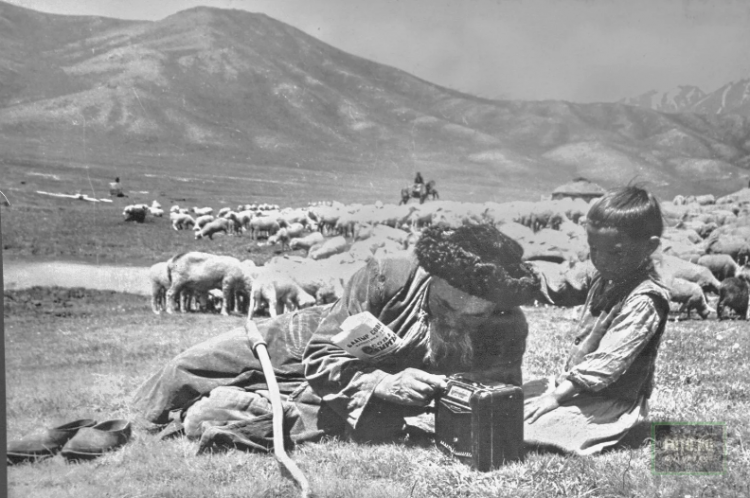
As a result of the titanic efforts of the Communist Party and the selfless labor of the working...

Aktanov Toichu Kuluntay Uulu (1910-1942) - a representative of the first generation of Kyrgyz...

In Russia, the names of 40 Kyrgyzstani soldiers, who were considered missing during the war, have...

RESOLUTION OF THE COUNCIL OF PEOPLE'S COMMISSARS OF THE KYRGYZ SSR "ON THE CONSTRUCTION...

In April 1942, the Soviet People's Commissariat and the Central Committee of the VKP(b) of...

In collaboration with the district party committees, relying on the rural activists, the political...

DECISION OF THE EXECUTIVE COMMITTEE OF THE FRUNZE CITY COUNCIL OF WORKING DEPUTIES ON THE...

Beksalov Esengeldi Beksalovich (1942), Doctor of Technical Sciences (1987). Kazakh. Born in the...

Daniyarov Bazarkul (1897-1942) - educator, scholar-pedagogue, political figure....

Arapov Bayysh (1942), Doctor of Physical and Mathematical Sciences (1993), Professor (1995)...

Many female field workers have gained fame in the struggle for high yields of technical crops. In...

Turkestan Shikra Status: VI category Near Threatened, NT: R. One of ten species of the genus in...

Eurasian Eagle-Owl Status: VII, Least Concern, LC. In Kyrgyzstan, Bubo bubo hemachalanus Hume,...

The various types of transport in the republic that grew during the years of Soviet power—railway,...
A Japanese song in the traditional Japanese genre of "enka," titled "Wanderer of...

Togolok Moldo (real name — Bayymbet Abdrakhmanov, 1860—1942) — an outstanding manaschi and...

DECREE OF THE COUNCIL OF PEOPLE'S COMMISSARS OF THE KYRGYZ SSR AND THE CENTRAL COMMITTEE OF...

The sudden attack of fascist Germany and the unfavorable development of military actions on the...

Animal Husbandry The main direction in the multi-sector agricultural production of Kyrgyzstan was...

Prose writer F. Samokhin was born in the village of Verkhne-Sadovskoye, Lower-Chirsky District of...

The party, Soviet, land authorities, and leaders of collective and state farms did everything...

The communication authorities also improved their work. In a record short time—from July to...

The results of 1941 indicate the enormous economic potential of the collective farms and state...

Emergency measures were taken to increase the extraction of fuel, primarily coal. Assessing the...

Snow Leopard Status: III. Critically Endangered, CR C2a(i): R, C1....

Saker Falcon Status: IV category, Endangered, EN, A2bcd+3bcd. The population of the species in...

FROM THE DECREE OF THE COUNCIL OF PEOPLE'S COMMISSARS OF THE KYRGYZ SSR AND THE CENTRAL...

Barbary Falcon Status: Category III, Critically Endangered, CR: R. Kyrgyz ornithologists believe...

Poet Dzh. Jamgyrchiev was born in the village of Kok-Sai in the present-day Ton district of the...

Lynx Status: V! category, Nearly Threatened, NT. A rare subspecies Lynx lynx isabellinus Blyth,...

Sharshen Termechikov (1896—1942) — a popular comic-satirist, honored artist of the Kyrgyz SSR,...

Aral Barbel Status: 2 [CR: C]. Species extinct in Kyrgyzstan....

Industrial Construction in All Rear Areas of the Soviet Union In the Kyrgyz SSR, as in all rear...

FROM THE REPORT OF THE COUNCIL OF MINISTERS OF THE KYRGYZ SSR TO THE COUNCIL OF MINISTERS OF THE...

FROM THE RESOLUTION OF THE BUREAU OF THE FRUNZE CITY COMMITTEE OF THE COMMUNIST PARTY (BOLSHEVIKS)...

Bernsham Alexander Natanovich (1910-1956), Doctor of Historical Sciences (1942), Professor (1946)....

Houbara Bustard Status: III category, Critically Endangered, CR: R, A1. The subspecies Chlamydotis...

Poet S. Kadyrov was born on March 15, 1942, in the village of Nichke, Uzgen district, Osh region,...

Mobilization of All Internal Resources of the Kyrgyz SSR Speedy construction methods, which...

Pink Pelican Status: VI category, Near Threatened, NT: R. One of 2 species of the genus, rarely...

Olga Maximilianovna Manuilova (1893-1984) Sculptor. People's Artist of the Kyrgyz SSR. Born...

First Wartime Plan On June 30, 1941, the Council of People's Commissars of the USSR approved...

Pike Asp Status: 2 [CR: A]. Listed in the Red Book of the Kyrgyz SSR in 1984. A rare...

Prose writer and translator M. Aksakov was born in Voronezh in a family of an agronomist-forester....

The Coalition of Three Powers Against Hitler As a result of the active resistance of the Soviet...